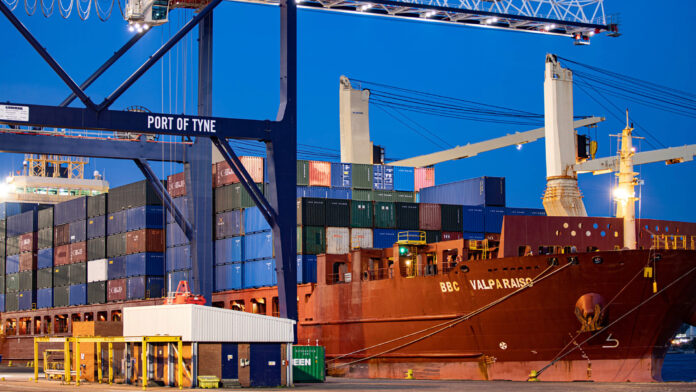The Port of Tyne has deployed a private 4G and 5G network across its southern cargo terminal and industrial site in South Shields in the northeast of England. The project has been managed by UK operator BT, which has provided localised tranches of its licensed b7 and (2.6 GHz) and n77 (3.7 GHz) spectrum for the exclusive management of 4G (LTE) and 5G applications, respectively, by the port authority and clients. Network vendor Ericsson has supplied a dual private 4G/5G core network, resident on site, and localised radio access network (RAN) infrastructure.
The network is live, and presented by the three parties as the UK’s “first site-wide private network deployment… for smart port applications”. A statement said the network covers the entire port estate; in fact, it is understood it focuses on the southern industrialised port area, at South Shields, one of the country’s key deep sea shipping ports. The northern side, at North Shields, is home to a car terminal, cruise terminal, and ferry terminal, and is expected to be connected on private 5G in the future – with longer-term plans to extend the network operations further afield, as well.
The twin LTE and 5G NR networks will “operate simultaneously” to support legacy devices as well as new industrial IoT applications. Port of Tyne will manage the day-to-day network, with BT available for support. The first applications will be hooked up to the network this month, with video and sensor devices being installed at each gate on the site to use automatic number plate recognition (ANPR) to manage and track vehicles on the site. As well, a number of machine vision cameras, running edge AI software and connected to the 5G network, will deliver a 360-degree view at the quayside cand deliver automated container checks.
Future applications will include autonomous vehicles and navigation technology (“so vehicles can move cargoes and equipment around the port”), remote crane operations (so “operators [can] work from simulated cabs”), survey drones at land and sea (to “autonomously inspect cranes, quayside, buoys and other infrastructure”), wearable technology and augmented and virtual reality (AR/VR) devices (“for immersive training and remote maintenance”), and a connected system of AI-geared IoT sensors (“to generate new business intelligence and improve efficiency”).
The dynamic nature of shipping ports, often with changeable industrial sites, makes advanced wireless networks, such as enabled by 5G, a good option – compared with “trenching through concrete” to lay and relay underground fibre cable. Ericsson said: “[Such methods] are costly and inflexible… [and] simply not feasible for a business… that reconfigures its physical site multiple times each year.”
Ian Blake, head of innovation and technology at Port of Tyne, said: “You can be sure as soon as we build a new piece of infrastructure, those underground ducts are going to be in the wrong place. Once you’ve got wireless connectivity, you can start to connect all areas of the site even as they are reconfigured. And it allows connecting moving assets like vehicles that are around the site.” Blake will appear at Industrial 5G Forum next week (November 7) to discuss the port’s 5G rollout and digital transformation strategy; sign-up here to catch all the sessions.
Ericsson also made the argument that cellular delivers better mobility and better coverage, compared to traditional wireless networking technologies. It stated: “Innovative use cases such as autonomous vehicles and automated container inspection are only possible with fast, reliable wireless connectivity… Port of Tyne’s site extends across both sides of the River Tyne, which is difficult to connect using traditional network technologies.” The vision for the port, as with all digital change projects, is to “streamline operations, improve safety, reduce emissions, and drive innovation.”
Port of Tyne is hosting the UK government’s 2050 Maritime Innovation Hub to stimulate practical collaboration between the enterprise and academic sectors to drive innovation in the logistics industry. Port of Tyne said it wants to be a “leader in 5G maritime innovation and provide an industry ecosystem testbed to help build a future blueprint of 5G-enabled smart applications to automate manual tasks, improve decision-making and reduce CO2 emissions”.
Matthew Beeton, chief executive at Port of Tyne, said: “5G is going to play a crucial role in helping Port of Tyne achieve our goals. We can streamline our operations, improve safety and sustainability, and drive growth and innovation throughout the entire maritime industry and beyond. With seamless connectivity, we can link shipping companies, logistics providers, and regulatory bodies from around the world, enabling us to work together more effectively to address global challenges like climate change and cybersecurity threats.”
Ashish Gupta, managing director of corporate and public sector business at BT, said: “What makes 5G so exciting is it allows innovative use cases which help businesses do things quicker, safer, smarter, better. At Port of Tyne, it’s about taking people out of harm’s way, where autonomous machines could instead be used in dangerous environments, and laying the digital foundations to introduce new technologies and improve efficiency at the port.”
Duncan Hawkins, vice president of dedicated networks and enterprise wireless solutions at Ericsson, said: “This deployment serves as a great model of maritime innovation for the UK and the world. 5G brings the essential characteristics such as coverage, speed and low latency to leverage new applications and use cases required to transform port operations, drive business efficiencies, and build a blueprint for sustainability success and future economic growth.”


